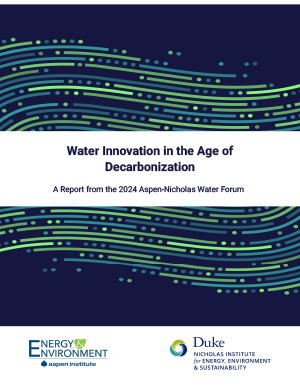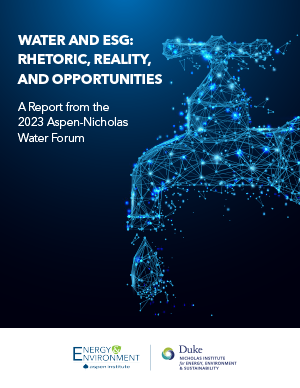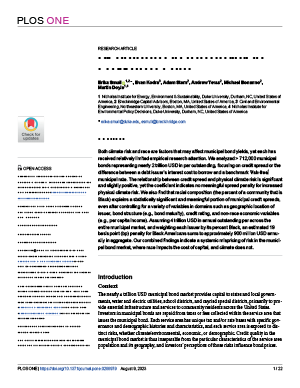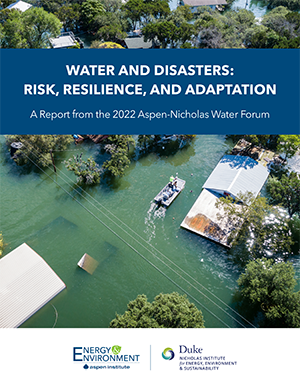Publications
Water Innovation in the Age of Decarbonization
The 2024 Aspen-Nicholas Water Forum focused on identifying innovative technologies, policy frameworks, business models, and institutional structures to enable decarbonization and adaptation within the water sector as well as the sector’s role in decarbonizing the broader economy. Forum participants explored key questions such as: How is innovation disrupting the water sector? How does water fit into broader decarbonization efforts?
Meet the Mississippi
"The challenge for any writer taking on the Mississippi is balancing scope with readability, and this is where Upholt's book makes a real contribution," writes Martin Doyle, director of the Water Policy Program, in this review of Boyce Upholt's The Great River. Doyle discusses the book's place among the many volumes about the river's impact and history.
Water and ESG: Rhetoric, Reality, and Opportunities
Building on the ongoing theme of “What does good water governance look like for the United States?,” the objective of the 2023 Aspen-Nicholas Water Forum was to explore why, despite the centrality of water to the environment, as well as to communities and society broadly, water has simply been overlooked in environmental, social, and governance (ESG) goal-setting processes, analyses, or frameworks. The forum also asked what might be the opportunities, or risks, of greater inclusion of water into ESG generally. This report highlights the discussions at the forum on how ESG does, and does not intersect with water, and what the challenges or opportunities might be.
Development and Deployment of a Lead Service Line Inventory Application for North Carolina Water Utilities
This white paper presents an application designed to help North Carolina water utilities complete federally required lead service line inventories. Using available datasets, the application simplifies the inventory process, reduces software barriers, details development and utility engagements, and proposes enhancements for broader use. The paper highlights methods and future improvements, aiming to extend the tool's reach to help utilities nationwide manage lead contamination efficiently.
Emerging Roles for Finance in River Restoration and Resilience
River restoration has primarily relied on public sources for funding projects, such as agency-based grants and philanthropy. More recently, there is growing interest in the potential role of private finance to offset the declines in public funding and to potentially increase the scale and scope of river restoration overall. This chapter, part of the book Resilience and Riverine Landscapes, reviews broad concepts in finance and then describes two broad types of private sector approaches to capitalizing restoration projects: voluntary markets and regulatory markets.
Climate, Race, and the Cost of Capital in the Municipal Bond Market
Both climate risk and race are factors that may affect municipal bond yields, yet each has received relatively limited empirical research attention. The authors analyzed >712,000 municipal bonds representing nearly 2 trillion USD in par outstanding, focusing on credit spread or the difference between a debt issuer’s interest cost to borrow and a benchmark “risk-free” municipal rate. The authors' combined findings indicate a systemic mispricing of risk in the municipal bond market, where race impacts the cost of capital, and climate does not.
Accounting for Residential Nonpayment Risk for Water Utility Financial Sustainability
Residential “nonpayment risk” for water utilities—the risk of revenue loss from residential customers not paying water bills—is a financial threat for water service providers that remains poorly understood. The authors developed a new heuristic model to categorize and evaluate water utility pricing (rate setting) strategies responsive to the effects of nonpayment (i.e., delinquency) on water utility revenues. The model is the first attempt, to our knowledge, to theorize the impact of residential nonpayment on utility revenues.
Affordability of Household Water Services Across the United States
Households that cannot afford their water bills may lose access to drinking water and wastewater services. This study seeks to quantify how many households may struggle to pay for water services across 787 of the largest drinking water providers in the United States. It finds that basic water services are unaffordable for 17% of households analyzed (28.3 million persons). The authors select 6,000 gallons per month as sufficient to meet basic needs and define undue hardship as spending more than 4.6% of household income (one day of labor each month) to pay for water services.
Water and Disasters: Risk, Resilience, and Adaptation
The 2022 Aspen-Nicholas Water Forum explored what must be done to ensure the water sector becomes more resilient to water-related disasters. How can communities navigate and prepare for the impacts of increasingly common water-related disasters. How do we reconcile different values as individuals, businesses, and government negotiate who receives resources to mitigate, adapt, and recover?
Technology Adoption at Public Agencies: Identifying Challenges and Building Opportunities to Modernize Public Water Data Infrastructure
Modernizing public agency water data depends not only on technology adoption, but also on transformation of how data are managed, shared, and used for decision-making. The Duke Internet of Water (IoW) Technology Adoption Program (TAP) addresses both. This report details efforts by IoW to identify challenges faced by public agencies and recommends a technology adoption roadmap based on nationwide surveys and interviews, best practices identified by public interest technologists, and the principles of modern data infrastructure, along with a case study on the New Mexico Water Data Initiative.










